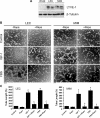Rapamycin inhibits lymphatic endothelial cell tube formation by downregulating vascular endothelial growth factor receptor 3 protein expression
- PMID: 22496622
- PMCID: PMC3323900
- DOI: 10.1593/neo.111570
Rapamycin inhibits lymphatic endothelial cell tube formation by downregulating vascular endothelial growth factor receptor 3 protein expression
Abstract
Mammalian target of rapamycin (mTOR) controls lymphangiogenesis. However, the underlying mechanism is not clear. Here we show that rapamycin suppressed insulin-like growth factor 1 (IGF-1)- or fetal bovine serum (FBS)-stimulated lymphatic endothelial cell (LEC) tube formation, an in vitro model of lymphangiogenesis. Expression of a rapamycin-resistant and kinase-active mTOR (S2035T, mTOR-T), but not a rapamycin-resistant and kinase-dead mTOR (S2035T/D2357E, mTOR-TE), conferred resistance to rapamycin inhibition of LEC tube formation, suggesting that rapamycin inhibition of LEC tube formation is mTOR kinase activity dependent. Also, rapamycin inhibited proliferation and motility in the LECs. Furthermore, we found that rapamycin inhibited protein expression of VEGF receptor 3 (VEGFR-3) by inhibiting protein synthesis and promoting protein degradation of VEGFR-3 in the cells. Down-regulation of VEGFR-3 mimicked the effect of rapamycin, inhibiting IGF-1- or FBS-stimulated tube formation, whereas over-expression of VEGFR-3 conferred high resistance to rapamycin inhibition of LEC tube formation. The results indicate that rapamycin inhibits LEC tube formation at least in part by downregulating VEGFR-3 protein expression.
Copyright © 2012 Neoplasia Press, Inc.
Figures






Similar articles
-
Cryptotanshinone inhibits lymphatic endothelial cell tube formation by suppressing VEGFR-3/ERK and small GTPase pathways.Cancer Prev Res (Phila). 2011 Dec;4(12):2083-91. doi: 10.1158/1940-6207.CAPR-11-0319. Epub 2011 Aug 31. Cancer Prev Res (Phila). 2011. PMID: 21881029 Free PMC article.
-
Synergistic effects of mTOR inhibitors with VEGFR3 inhibitors on the interaction between TSC2-mutated cells and lymphatic endothelial cells.Sci China Life Sci. 2025 Jun;68(6):1676-1688. doi: 10.1007/s11427-024-2760-4. Epub 2025 Jan 22. Sci China Life Sci. 2025. PMID: 39862344
-
Sunitinib inhibits lymphatic endothelial cell functions and lymph node metastasis in a breast cancer model through inhibition of vascular endothelial growth factor receptor 3.Breast Cancer Res. 2011 Jun 21;13(3):R66. doi: 10.1186/bcr2903. Breast Cancer Res. 2011. PMID: 21693010 Free PMC article.
-
mTOR signaling in cancer cell motility and tumor metastasis.Crit Rev Eukaryot Gene Expr. 2010;20(1):1-16. doi: 10.1615/critreveukargeneexpr.v20.i1.10. Crit Rev Eukaryot Gene Expr. 2010. PMID: 20528734 Free PMC article. Review.
-
Lymphatic Malformation: Classification, Pathogenesis, and Therapeutic Strategies.Ann Vasc Surg. 2025 May 23;121:35-46. doi: 10.1016/j.avsg.2025.05.028. Online ahead of print. Ann Vasc Surg. 2025. PMID: 40414533 Review.
Cited by
-
Overcoming intratumor heterogeneity of polygenic cancer drug resistance with improved biomarker integration.Neoplasia. 2012 Dec;14(12):1278-89. doi: 10.1593/neo.122096. Neoplasia. 2012. PMID: 23308059 Free PMC article.
-
Rapamycin suppresses angiogenesis and lymphangiogenesis in melanoma by downregulating VEGF-A/VEGFR-2 and VEGF-C/VEGFR-3 expression.Onco Targets Ther. 2019 Jun 13;12:4643-4654. doi: 10.2147/OTT.S205160. eCollection 2019. Onco Targets Ther. 2019. PMID: 31354297 Free PMC article.
-
Quantitative analysis of computed tomography of the lungs in patients with lymphangioleiomyomatosis treated with sirolimus.Heliyon. 2020 Feb 6;6(2):e03345. doi: 10.1016/j.heliyon.2020.e03345. eCollection 2020 Feb. Heliyon. 2020. PMID: 32072050 Free PMC article.
-
Isolated fetal lymphatic malformation of the thigh: prenatal diagnosis and follow-up.Autops Case Rep. 2017 Mar 30;7(1):49-53. doi: 10.4322/acr.2017.009. eCollection 2017 Jan-Mar. Autops Case Rep. 2017. PMID: 28536688 Free PMC article.
-
The impact of sirolimus therapy on lesion size, clinical symptoms, and quality of life of patients with lymphatic anomalies.Orphanet J Rare Dis. 2019 Jun 13;14(1):141. doi: 10.1186/s13023-019-1118-1. Orphanet J Rare Dis. 2019. PMID: 31196128 Free PMC article.
References
-
- Lohela M, Bry M, Tammela T, Alitalo K. VEGFs and receptors involved in angiogenesis versus lymphangiogenesis. Curr Opin Cell Biol. 2009;21:154–165. - PubMed
-
- Raica M, Ribatti D. Targeting tumor lymphangiogenesis: an update. Curr Med Chem. 2010;17:698–708. - PubMed
-
- Proud CG. mTOR signalling in health and disease. Biochem Soc Trans. 2011;39:431–436. - PubMed
-
- Loewith R, Jacinto E, Wullschleger S, Lorberg A, Crespo JL, Bonenfant D, Oppliger W, Jenoe P, Hall MN. Two TOR complexes, only one of which is rapamycin sensitive, have distinct roles in cell growth control. Mol Cell. 2002;10:457–468. - PubMed
Publication types
MeSH terms
Substances
Grants and funding
LinkOut - more resources
Full Text Sources
Other Literature Sources
Miscellaneous
